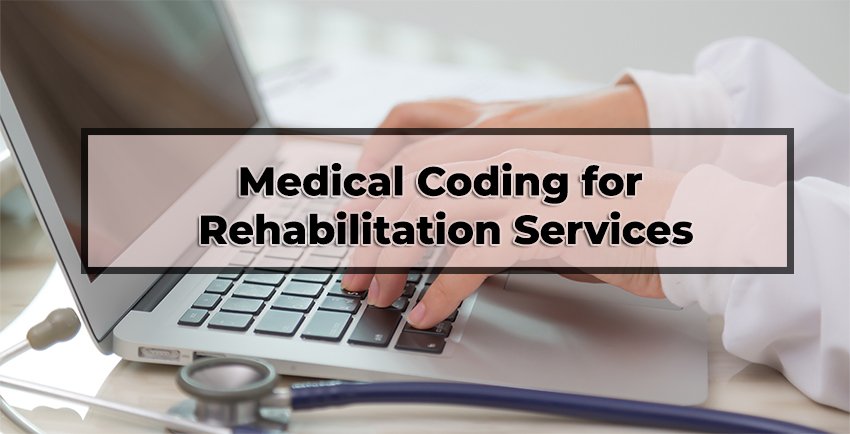Medical Coding for Rehabilitation Services
Rehabilitation services are a crucial aspect of healthcare, focusing on helping patients recover from injuries, surgeries, or managing chronic conditions that affect mobility, strength, and overall physical function. These services are designed to restore function, improve the quality of life, and reduce the risk of long-term disabilities. Rehabilitation services can include physical therapy (PT), occupational therapy (OT), and speech-language pathology (SLP), all tailored to meet the unique needs of each patient.

Accurate medical coding for rehabilitation services ensures that healthcare providers receive proper reimbursement while maintaining compliance with payer policies. Coders must use a combination of CPT (Current Procedural Terminology) and HCPCS codes to document rehabilitation services, and they need to understand how to link these services to the patient’s diagnosis through ICD-10-CM codes. Proper coding not only supports timely reimbursement but also reflects the patient’s progress and care plan.
Key Components of Rehabilitation Services Coding
Rehabilitation services include a variety of treatments and interventions aimed at helping patients regain function. Coders must be familiar with the specific codes for each service and understand how to document the services provided accurately.
1. Physical Therapy (PT):
Physical therapy is aimed at improving mobility, strength, and coordination. Common PT services include therapeutic exercises, manual therapy, and gait training. For instance, CPT code 97110 is used for therapeutic exercises to develop strength, endurance, and range of motion, while CPT code 97140 covers manual therapy techniques like joint mobilization or manipulation.
Coders must document the specific type of therapy provided and the number of units used, as PT services are often time-based and billed in units.
2. Occupational Therapy (OT):
Occupational therapy focuses on helping patients regain the ability to perform daily activities. CPT code 97530 is used for therapeutic activities designed to improve functional performance, while CPT code 97112 is used for neuromuscular re-education, such as balance and coordination exercises.
Coders must accurately reflect the patient’s functional goals and link the therapy provided to the diagnosis requiring rehabilitation.
3. Speech-Language Pathology (SLP):
Speech therapy helps patients improve their communication and swallowing abilities. CPT code 92507 is used for speech, language, or swallowing therapy, while CPT code 92526 is used for treating swallowing dysfunction or oral function disorders.
Coders must document the type of therapy provided, whether it’s for language, speech, or swallowing, and ensure that the correct codes are applied based on the treatment plan.
Special Considerations in Rehabilitation Services Coding
Rehabilitation services coding involves unique considerations, including time-based coding, linking diagnoses to the therapies provided, and understanding payer-specific policies.
Time-Based Coding:
Many rehabilitation services are time-based, meaning coders must document the exact time spent delivering therapy. For example, services like therapeutic exercise and manual therapy are typically billed in 15-minute increments. Coders need to track and record the time spent on each type of therapy and ensure that the number of units billed reflects the time spent with the patient.
Linking Diagnosis to Therapy:
Coders must ensure that the therapy provided is linked to the patient’s diagnosis. For example, a patient receiving PT for a knee replacement would have the diagnosis code Z96.651 (aftercare following a joint replacement of the knee). The therapy codes should align with the rehabilitation goals for the condition being treated. Proper documentation is essential for demonstrating medical necessity.
Medicare and Payer Guidelines:
Medicare and private insurers often have specific guidelines for rehabilitation services, including therapy caps or limits on the number of sessions allowed. Coders must stay updated on payer requirements and ensure that the therapy provided is within the payer’s coverage limits. For example, Medicare applies therapy caps for PT and OT, but these can be exceeded if deemed medically necessary, which requires additional documentation.
Challenges in Coding for Rehabilitation Services
One of the key challenges in rehabilitation services coding is managing the time-based nature of many therapy services. Coders must ensure that the time spent on therapy is documented accurately, and they need to apply the correct number of units to each service provided. Failing to track therapy time correctly can lead to billing errors and claim denials.
Another challenge is ensuring that all rehabilitation services are medically necessary and properly documented. Payers often scrutinize rehabilitation claims, especially when therapy extends beyond the typical duration. Coders must work closely with healthcare providers to ensure that the patient’s progress, treatment goals, and need for continued therapy are well-documented to support the claim.
Best Practices for Accurate Rehabilitation Services Coding
Precise Time Documentation: Coders should work with therapists to ensure that the exact time spent on each therapy session is recorded. This includes tracking when therapy starts and ends, as well as noting any breaks or interruptions. Time-based codes should reflect the time actually spent providing therapy, ensuring accurate billing.
Document Functional Progress: Providers should document the patient’s functional progress in detail, including improvements in mobility, strength, coordination, or daily function. Coders need this documentation to support the therapy’s medical necessity and to justify any continued care beyond initial treatment.
Stay Updated on Payer Policies: Coders should stay informed about payer-specific guidelines, therapy caps, and documentation requirements. Medicare and private insurers may have different rules for rehabilitation services, and coders must ensure compliance with these policies to avoid claim rejections.
Medical coding for rehabilitation services is an essential aspect of documenting and billing for physical, occupational, and speech therapy. Coders play a crucial role in ensuring that these services are accurately reflected in patient records and that providers receive proper reimbursement for the care provided. Rehabilitation coding requires an understanding of time-based services, payer-specific guidelines, and the ability to link therapy services to the patient’s diagnosis.
Accurate coding for rehabilitation services not only supports timely reimbursement but also ensures that patients receive the care they need to recover from injuries, surgeries, and chronic conditions. Coders are instrumental in helping healthcare providers deliver quality care while navigating the complexities of rehabilitation billing and payer requirements.

